
The consumer secrets that drive B2B marketing
In B2B marketing, the first lesson to learn is that behind every business decision is a consumer. Whether you’re targeting an enterprise or an early-stage startup, each business comprises individuals. In the end, we’re all human, we’re all consumers, and we all buy things for certain reasons.
In a recent Oktopost webinar, Jamie Turner, Founder of The 60 Second Marketer and 60 Second Communications, said, “A driving force behind the improvement of B2B marketing ROI is the fact that B2B marketers are now viewing their customers as individuals, rather than an enterprise entity.” To better understand how to leverage the “human” approach to B2B marketing, Jamie distinguished between the B2B and B2C cycles.
Key differences between B2B and B2C
- Closer Buyer-Customer Relationships: B2B is all about relationship marketing that’s based on long-term trust, credibility, and reliability.
- Multiple Stakeholders: B2B buying decisions are influenced by a number of people at different levels, not just one or two people.
- Longer Sales Cycle: B2B purchases are usually more complex, expensive, and involve numerous people; the cycle is longer and slower.
- Higher Price Points: B2B transactions are more expensive than B2C and are largely based on logic, objectives, benefits, and ROI.
- Fewer, Larger Buyers: B2B target prospects can be narrowed down by industry, company size, geographic area, etc.
B2C motivators that can improve your B2B marketing
When we think about the word “brand,” we often associate it with B2C much faster than B2B. Despite the differences, branding matters in B2B marketing for one simple reason: B2B buyers are people, and people have emotions that can impact economic decision-making.
Jamie described this perfectly: “People buy for emotional reasons and then rationalize their purchases with logic.” While about 80% of B2B purchases are driven by logic, emotion accounts for the remaining 20%, and leveraging this can help differentiate you from competitors.
As a B2B marketer, your job is to discover these reasons and incorporate them into your nurturing efforts. For example, launch a feedback survey, call new and long-time customers, and try to uncover these hidden reasons to convert more future prospects into customers.
Many will tell you they purchased your product or service for logical reasons, such as pricing, better terms, or certain features. However, dig deeper and see if you can find out whether it was also because they really liked your team or even a particular salesperson.
More often than not, you’ll discover that part of the decision was influenced by alternative reasons, such as how your company made them feel, a personalized approach, or even a unique customer support experience early on.
Jamie offered one B2C example to help visualize the complexity behind purchasing decisions: buying a cup of coffee. He asked, “What are people really buying when they purchase a cup of coffee?”
The reasons could be far beyond the flavor or price of the coffee; it could be the background music, the ambiance, or even a favorite barista.
Recommended for further reading
The 4 types of B2B customers you need to know
Jamie noted that B2B customers are extremely varied, but it’s fair to say the majority make a purchasing decision for one of the following reasons.
Any of these reasons may account for the majority of a purchasing decision. Still, there is often an added emotional driver – even if it’s minimal, that can make an impact, especially when considering the last two types on the list.
What types of B2B consumers exist?
- Price-Oriented Customers: Price. Is. Everything.
- Solutions-Oriented Customers: This type seeks low prices but will still respond to arguments about lower total cost or more dependable service.
- Gold Standard Customers seek the best performance regarding product quality, assistance, and reliable delivery.
- Strategic-Value Customers: Seek a fairly permanent supplier relationship with your company; the relationship is crucial to the equation.
So, before you launch the next B2B marketing campaign…
Now that you realize the potential impact of emotion on a B2B buyer and the types of buyers that exist, Jamie suggested asking 10 questions before planning your B2B marketing campaign.
These questions are intended to help you understand which specific players are involved in the purchasing decision, what matters to them, and what “hidden” factors – such as brand perception and even the season, can influence this.
10 Questions to help guide your B2B marketing
- Who is the target persona that is buying your products or services?
- Who makes the final decision to buy the product?
- Who are all the “behind the scenes” people who influence this?
- What is the customer really buying?*
- Why do customers buy your brand?
- Where do they go or look before buying your product?**
- When do they buy your product? Are there any seasonal factors?
- How do customers perceive your product?***
- What other factors might influence the purchase decision?
- How do personal/demographic factors influence purchase decisions?
*What is the customer really buying?
After compiling a list of all the people behind the purchasing decision, you’ll know what to emphasize when communicating with each one.
For example, Jamie noted that C-Level execs are most interested in ROI and results, management wants to look like a “hero” for buying the right product, and the junior staff wants a seamless transition without any logistical problems.
In other words, your B2B marketing strategy needs to change based on the level of person you’re selling to in the company.
**Where do they go or look before buying your product?
Interestingly enough, the secret here is not to ask your customers which other companies they looked at before choosing your product. The trick is to research people who were prospects and who didn’t end up going with your company.
According to Jamie, those are the people who will give you the real information that can drive your B2B marketing. Try to understand why they ultimately reached the end of your sales funnel but decided to choose a competitor instead.
***8. How do customers perceive your product?
Two words: social listening. Monitoring social channels frequently is critical to understanding what the public thinks of your product or service. For B2B companies, Twitter and LinkedIn (specifically Groups) are vital to this.
Track all mentions of your company across social channels and engage with them, regardless of whether their feedback is positive or negative.
A quick tip: Create a Twitter list to follow competitor mentions to research what consumers like or dislike about their products.
Takeaways to remember about the B2B buying cycle
Jamie mentioned three takeaways you should consider when creating a B2B marketing strategy.
- Unlike B2C markets, B2Bs have fewer, larger, more geographically concentrated buyers and closer customer relationships.
- The B2B buying process involves several people: initiators, users, influencers, deciders, approvers, buyers, and gatekeepers.
- B2B marketers are responsible for building relationships with customers and nurturing them down the funnel with valuable content.


